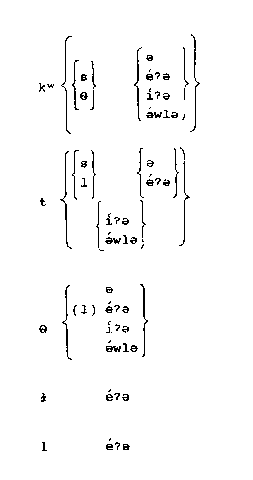| kʷɬ ‘realized’ | ʔiʔ ‘accompanying’ | čəɬ ‘immediate past’ |
| s ‘unrealized’ | ʔəw̕ ‘contemporaneous’ | təwə ‘still,yet’ |
| ə ‘yes/no question’ | č̕əʔ ‘evidential’ | ləʔ ‘past’ | sən ‘1st sg. subj.’ | q̕əʔ ‘emphatic’ |
| čə ‘command’ | yəq ‘optative’ | səʔ ‘future’ | ɬtə ‘1st pl. subj.’ | kʷəʔ ‘informative’ |
| yəxʷ ‘conjectural’ | yəxʷ ‘conjectural’ | ʔačə ‘request information’ | ||
| q ‘conditional’ | kʷəče ‘explanative’ | |||
| helə ‘2nd person pluralizer’ | ||||
| ʔal̕ ‘limiting’ |

1. This term and ‘contemporaneous’ have been used by others referring to cognate morphemes in other Coast Salish languages. See for example Thompson and Thompson (1971).
2. See §2.5 on other differences between transitives and intransitives.
3. The root ∥√ʔaŋ∥ actually means ‘give something to’. In this it is similar to English ‘endow’.